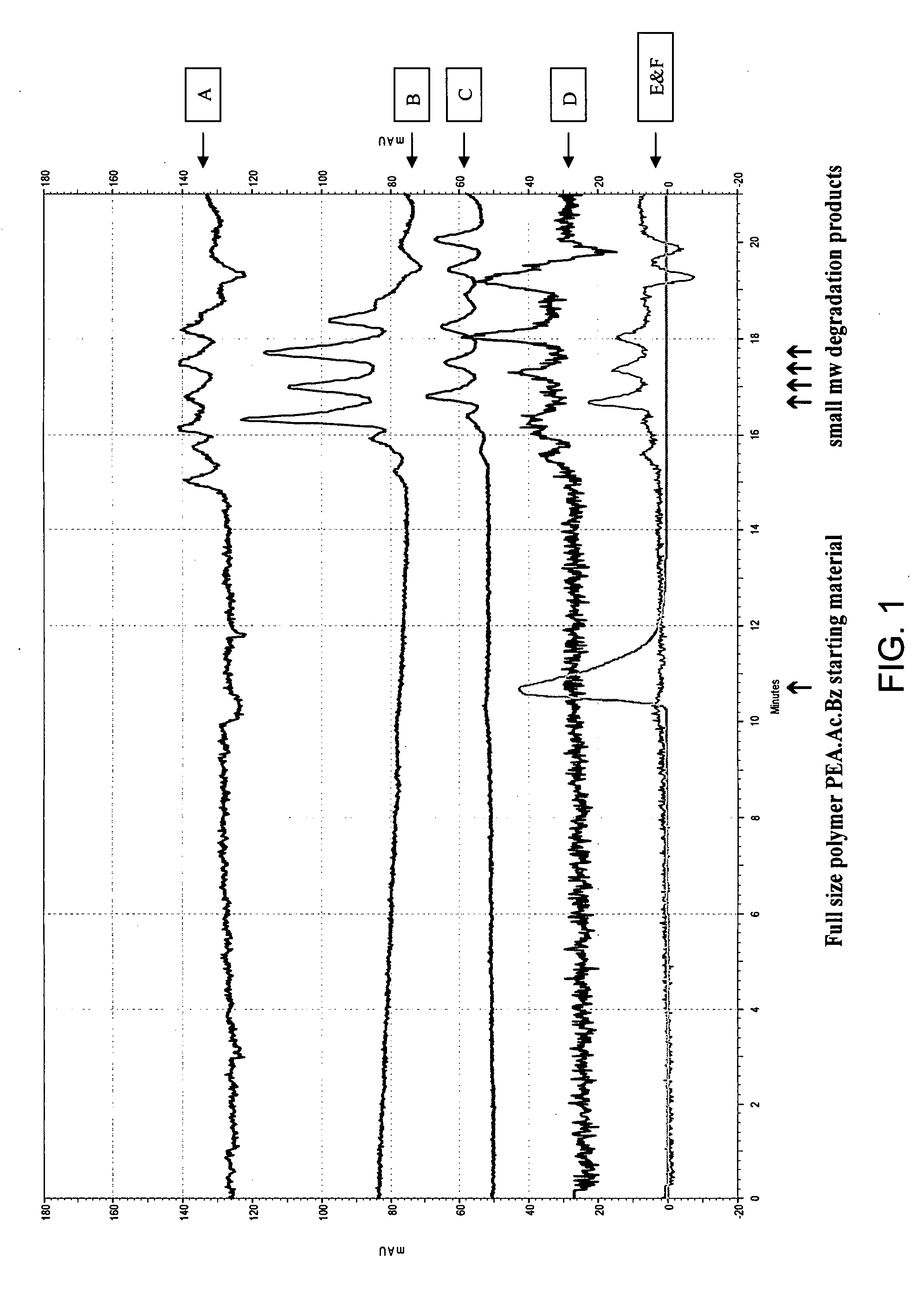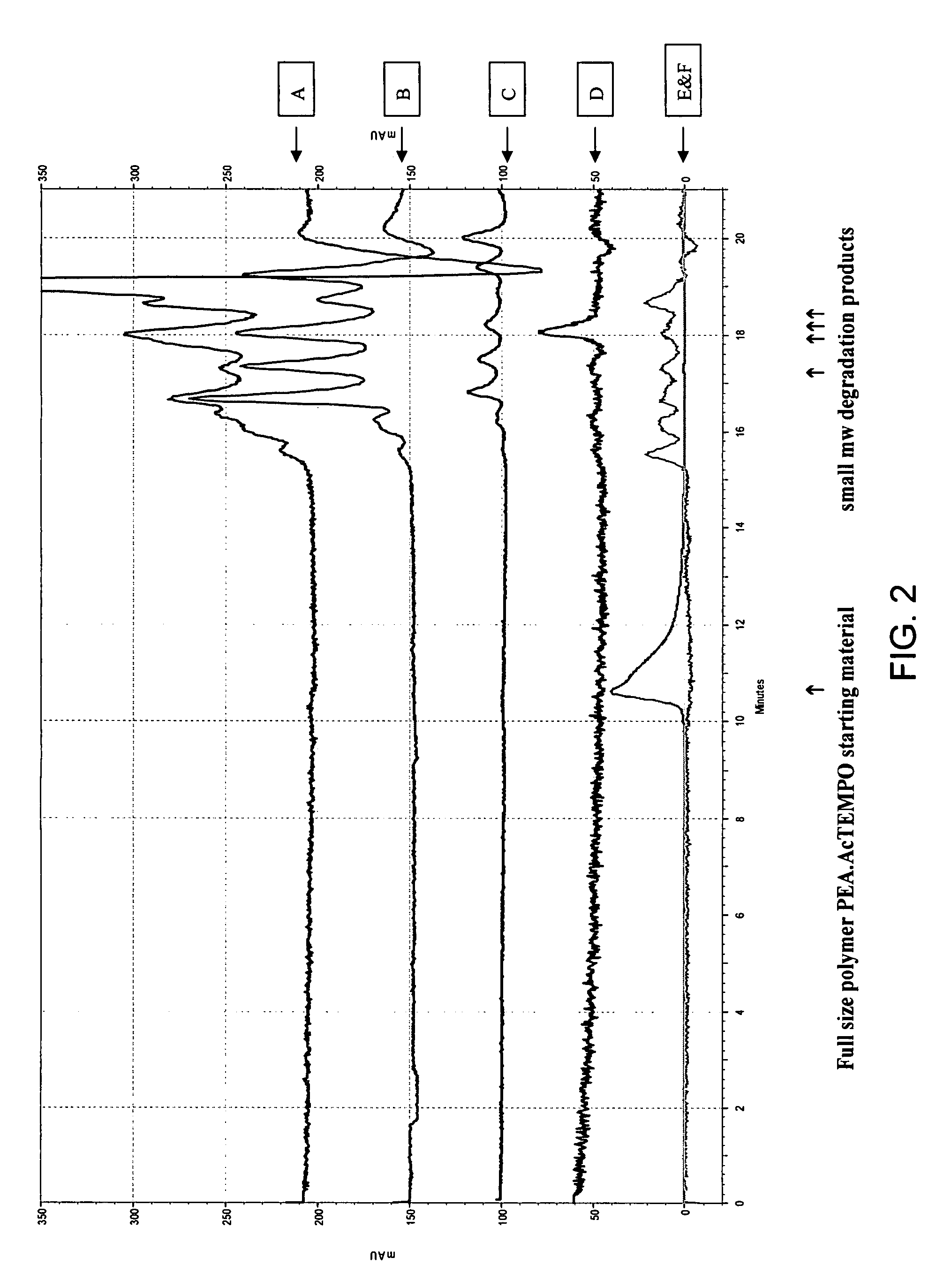Biodegradable polymer adhesion barriers
- Summary
- Abstract
- Description
- Claims
- Application Information
AI Technical Summary
Benefits of technology
Problems solved by technology
Method used
Image
Examples
example 1
[0112] This example illustrates preparation of a low molecular weight PEUR of co-poly-8-[Leu(6)0.75][Lys(Bz) 0.25], which is described by structural formula (IV), wherein m=0.75, p=0.25, R1=(CH2)8, R2═CH2Ph, R3═CH2CH(CH3)2, and R4═(CH2)6.
[0113] For synthesis of the PEUR, triethylamine (NEt3) (9.51 mL, 0.07 mole) was added to a mixture of di-p-toluenesulfonic acid salt of bis-(L-leucine)-1,6-hexylene diester (16.0237 g, 0.02 mole); di-p-toluenesulfonic acid salt of bis-(L-lysine(Bz)) (4.5025 g, 0.00775 mole) and di-p-nitrophenyl sebacinate (12.4051 g, 0.03 mole) in dimethylformamide (DMF) (13.75 mL) at room temperature. Afterwards, the temperature of the mixture was increased to about 60° C. and stirring continued for about 24 hours. The reaction solution was cooled to room temperature, diluted with DMF (123.72 mL) (total volume of DMF and NEt3 is 150 mL, concentration of 10% (w / v)). The reaction solution was thoroughly washed with water and sodium bicarbonate (1% w / v). For final pu...
example 2
[0115] This example illustrates preparation of a high molecular weight PEUR of co-poly-8-[Leu(6)0.75][Lys(Bz)0.25], which is described by structural formula (IV), wherein m=0.75, p=0.25, R1=(CH2)8, R2═CH2Ph, R3═CH2CH(CH3)2, and R4═(CH2)6 For synthesis, triethylamine (NEt3) (9.51 mL, 0.07 mole) was added to a mixture of di-p-toluenesulfonic acid salt of bis-(L-leucine)-1,6-hexylene diester (16.0237 g, 0.02 mole); di-p-toluenesulfonic acid salt of bis-(L-lysine(Bz)) (4.5025 g, 0.00775 mole) and di-p-nitrophenyl sebacinate (13.7834 g, 0.033 mole) in dimethylformamide (DMF) (16.33 mL) at room temperature. Afterwards, the temperature of the mixture was increased to about 60° C. and stirring continued for about 24 hours. The viscous reaction solution was cooled to room temperature, diluted with DMF (123.72 mL) (total volume of DMF and NEt3 is 150 mL, concentration of 10% (w / v)). Acetic anhydride (0.567 mL, 0.006 mole) was added and the reaction solution was stirred for about 16 hours. The...
example 3
[0117] This example illustrates two methods for applying the invention solvent-based PEA adhesion barrier composition to a surface of meat (fresh cut beef steak from the supermarket).
[0118] Method One: 6 g of a low molecular weight PEA 8-Leu(6 (GPC Mw 23,000 Da) was dissolved in 40 mL of reagent grade ethanol (15% wt / v). The resulting polymer-ethanol solution was loaded into a 50 mL Pfeiffer cartridge pump system. Then, the polymer-ethanol solution was sprayed onto the surface of fresh cut meat using the hand pump system. The ethanol solvent was either evaporated or absorbed by the tissue in one or two minutes, and a thin polymer film formed on the meat surface.
[0119] Method Two: 7 g of high molecular weight PEA 8-Leu(6) (GPC Mw 168 kDa) was dissolved in 35 mL Reagent grade ethanol (20% wt / v). A sufficient amount of the polymer-ethanol solution was painted onto the surface of the meat using cotton swabs to form a coating. A white polymer film formed in two to three minutes on the ...
PUM
| Property | Measurement | Unit |
|---|---|---|
| Time | aaaaa | aaaaa |
| Time | aaaaa | aaaaa |
| Thickness | aaaaa | aaaaa |
Abstract
Description
Claims
Application Information
 Login to View More
Login to View More - R&D
- Intellectual Property
- Life Sciences
- Materials
- Tech Scout
- Unparalleled Data Quality
- Higher Quality Content
- 60% Fewer Hallucinations
Browse by: Latest US Patents, China's latest patents, Technical Efficacy Thesaurus, Application Domain, Technology Topic, Popular Technical Reports.
© 2025 PatSnap. All rights reserved.Legal|Privacy policy|Modern Slavery Act Transparency Statement|Sitemap|About US| Contact US: help@patsnap.com



